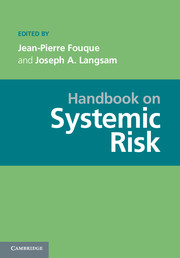Book contents
- Frontmatter
- Contents
- Contributors
- Introduction
- PART I DATA: THE PREREQUISITE FOR MANAGING SYSTEMIC RISK
- PART II STATISTICS AND SYSTEMIC RISK
- PART III MEASURING AND REGULATING SYSTEMIC RISK
- PART IV NETWORKS
- PART V SYSTEMIC RISK ANDMATHEMATICAL FINANCE
- PART VI COUNTERPARTY RISK AND SYSTEMIC RISK
- PART VII ALGORITHMIC TRADING
- PART VIII BEHAVIORAL FINANCE: THE PSYCHOLOGICAL DIMENSION OF SYSTEMIC RISK
- PART IX REGULATION
- PART X COMPUTATIONAL ISSUES AND REQUIREMENTS
- PART XI ACCOUNTING ISSUES
PART VII - ALGORITHMIC TRADING
Published online by Cambridge University Press: 05 June 2013
- Frontmatter
- Contents
- Contributors
- Introduction
- PART I DATA: THE PREREQUISITE FOR MANAGING SYSTEMIC RISK
- PART II STATISTICS AND SYSTEMIC RISK
- PART III MEASURING AND REGULATING SYSTEMIC RISK
- PART IV NETWORKS
- PART V SYSTEMIC RISK ANDMATHEMATICAL FINANCE
- PART VI COUNTERPARTY RISK AND SYSTEMIC RISK
- PART VII ALGORITHMIC TRADING
- PART VIII BEHAVIORAL FINANCE: THE PSYCHOLOGICAL DIMENSION OF SYSTEMIC RISK
- PART IX REGULATION
- PART X COMPUTATIONAL ISSUES AND REQUIREMENTS
- PART XI ACCOUNTING ISSUES
Summary
Algorithmic Trading
Over recent decades, advances in information technology have had a significant impact on the way in which financial markets are functioning. The traditional trading pits were abandoned and replaced by electronic order books. Orders can now be routed to electronic exchanges within fractions of a second from all over the world. This has led to an increased competition between exchanges and to the introduction of new types of trading platforms such as dark pools. As another consequence, it is now possible for computer programs to execute trades without involving humans. This type of trading is called algorithmic trading. In this Part, several aspects of algorithmic trading will be highlighted in two chapters.
The first of the chapters is by C.-A. Lehalle. It starts by giving an overview of the current, fragmented state of electronic markets in Europe and the United States, paying particular attention to the “mechanics” of the various novel trading platforms and to the new phenomenon of high-frequency market making. Highfrequency traders are now an essential part of electronic markets and hold a major share in all market transactions. Their presence has led to strongly increasing updating frequencies of limit order books and to a decrease of tick sizes. Today's trading speeds are so high that the transmission time of signals between the trader's computer and the exchange becomes a critical quantity. Markets therefore are increasingly depending on the performance of the hardware, and the software, components of trading systems.
- Type
- Chapter
- Information
- Handbook on Systemic Risk , pp. 545 - 548Publisher: Cambridge University PressPrint publication year: 2013



